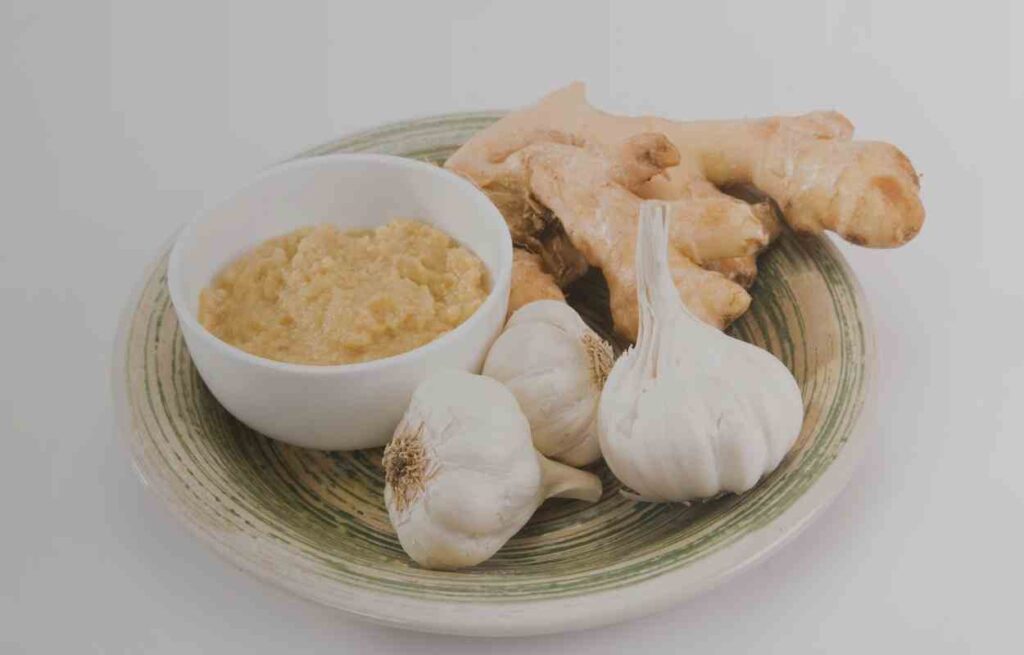Can You Substitute Ginger for Garlic?
Exploring the diverse culinary world often leads us to encounter situations where ingredient substitutions become necessary. Among the numerous versatile spices, ginger, and garlic stand out for their distinct flavors and aromas. But what if you find yourself in a pinch without one of these essential ingredients?
Can You Substitute Ginger for Garlic? No, ginger cannot be used in place of garlic in all recipes. While both ginger and garlic are pungent root vegetables, their tastes and culinary applications differ. Garlic has a harsh, biting flavor, whereas ginger has a warm, spicy flavor. Ginger is often used in Asian cuisine, but garlic is utilized in Western cuisine.
While ginger and garlic both belong to the same botanical family, they possess distinct flavors and aromas. Therefore, substituting ginger for garlic or vice versa may alter the taste profile of a dish.
However, certain recipes can accommodate these substitutions to a certain extent. It is recommended to experiment cautiously, considering the desired flavor and adjusting the quantities accordingly.

Can You Substitute Ginger for Garlic?
When it comes to substituting ginger for garlic or vice versa, it’s important to note that while they share a botanical family (Zingiberaceae), they offer distinct flavors and aromas.
Ginger imparts a warm, slightly sweet, and zesty taste, whereas garlic brings its pungent, savory, and slightly spicy notes. Thus, substituting one for the other may result in a noticeable difference in taste profiles.
However, in certain recipes, such as stir-fries or curries, where ginger and garlic serve as supporting flavors, limited substitutions can be explored. In such cases, minced ginger or a blend of ground ginger and garlic can be used as alternatives, though the intensity and balance of flavors may be altered.
It is essential to exercise caution, consider the desired outcome, and adjust the quantities accordingly to maintain the overall taste and character of the dish.
What Can I Substitute for Garlic?
1. Shallots: A Milder, Onion-like Alternative
Shallots can serve as a suitable substitute for garlic, offering a milder flavor profile. These small, bulbous onions bring a delicate, slightly sweet taste to dishes.
Use shallots in equivalent quantities as garlic to maintain the desired flavor balance in recipes. Shallots work well in various cuisines, including soups, stews, sauces, and dressings.
2. Chives: Adding Freshness and Mild Allium Flavor
Chives, with their slender green stalks, can be an excellent garlic substitute in certain recipes. These aromatic herbs belong to the onion family and provide a mild onion-like flavor.
Use chopped chives in place of minced garlic, ensuring to adjust the quantity based on taste preferences. Chives are particularly popular in salads, dips, omelets, and creamy sauces.
3. Cumin: Earthy and Nutty Aroma
If you’re looking to replace garlic’s distinctive flavor with something entirely different, cumin is a worthy choice. Cumin seeds or ground cumin can add an earthy and nutty essence to your dishes.
Use cumin sparingly and adjust the quantity to avoid overpowering other flavors in the recipe. This substitution works well in various cuisines, including Middle Eastern, Mexican, and Indian dishes.
4. Garlic Powder: Concentrated Flavor in a Convenient Form
When fresh garlic is unavailable, garlic powder can step in as a convenient substitute. Garlic powder offers a concentrated flavor, so use it sparingly and adjust the quantity according to taste.
Incorporate garlic powder into dishes during cooking or sprinkle it on finished recipes for added aroma. It works particularly well in dry rubs, marinades, seasoning blends, and spice mixes.
5. Asafoetida: A Pungent and Unique Alternative
Asafoetida, also known as Hing, is a resinous gum used as a substitute for garlic in some cuisines. This spice has a pungent aroma and imparts a distinct flavor reminiscent of onion and garlic.
Use a pinch of asafoetida while cooking to replace the flavor of garlic. Asafoetida is commonly used in Indian, Middle Eastern, and vegetarian dishes.
Do Garlic and Ginger Taste Good Together?
Garlic and ginger are an iconic duo in many culinary traditions, known for their complementary flavors that can elevate dishes to new heights.
The pungent, savory notes of garlic harmonize with the warm, zesty undertones of ginger, creating a delightful combination of tastes. Together, they bring a robust and aromatic dimension to a wide range of dishes, such as stir-fries, curries, marinades, and soups.
The marriage of garlic and ginger adds depth, complexity, and a hint of spiciness to the overall flavor profile. Whether it’s the bold kick of a garlic-ginger paste in a curry or the aromatic infusion in a stir-fry, these two ingredients have a natural affinity that tantalizes the taste buds.
Their harmonious blend can truly make a dish come alive and leave a lasting impression on your palate. So, if you’re seeking a flavor pairing that exudes deliciousness, garlic, and ginger make an exceptional team that is sure to satisfy and excite your culinary adventures.
Which Is Stronger Ginger or Garlic?
When it comes to comparing the potency of ginger and garlic, both ingredients possess distinct and powerful flavors, making it challenging to determine a clear winner. Ginger brings a warm, zesty, and slightly sweet taste with a hint of spiciness.
Its flavor profile can be intense, especially when used in larger quantities. On the other hand, garlic offers a pungent, savory, and sometimes sharp taste that can add a bold kick to dishes.
The strength of garlic’s flavor can vary depending on how it is prepared and cooked. It is worth noting that the strength of ginger and garlic can be influenced by personal taste preferences, the specific variety used, and the cooking method employed.
In some dishes, ginger may take the spotlight, while in others, garlic may dominate. Ultimately, the perceived strength of these ingredients is subjective and can be tailored to suit individual preferences and the desired flavor profile of a recipe.
How to Substitute Ginger Garlic Paste in Any Recipe?
Ginger garlic paste is a common and versatile ingredient in many recipes, but what if you find yourself without it? Don’t worry, there are several substitutes you can use to maintain the desired flavors in your dish.
1. Minced Ginger and Garlic
Peel and finely grate equal amounts of fresh ginger and garlic. Mix them together and adjust the moisture level with a splash of water. This mixture can be used immediately as a substitute for ginger garlic paste.
2. Ground Ginger and Garlic Blend
If fresh ingredients are not available, combine dried garlic powder and ground ginger in a small bowl. Use 1/8 teaspoon of garlic powder and 1/3 teaspoon of ground ginger for every 2 teaspoons of ginger garlic paste required. Add a splash of oil and mix into a thick paste. Lightly fry in oil along with other dried spices in your recipe.
3. Lemongrass
Use lemongrass as a substitute for ginger garlic paste. It has a minty and tart flavor that complements many dishes. Finely chop lemongrass and use it in the same quantity as ginger garlic paste.
4. Citrus Zest
Another alternative is to use orange or lemon zest. The tangy flavor of citrus zest complements the versatility of ginger garlic paste. Adjust the taste and texture according to your preferences.
5. Make Your Own Garlic Ginger Paste
If you have the time and ingredients, making your own garlic ginger paste from scratch is a great option. Blend equal parts of ginger and garlic with a splash of oil and any natural preservatives. Store in a jar and use a dry spoon when scooping out as needed.
When Should You Add Ginger-Garlic Paste to a Dish?
Adding ginger-garlic paste at the right time can significantly impact the flavor profile of your dish. As a general rule, it’s best to add the paste during the initial stages of cooking.
Sauté the paste in hot oil or ghee to release its aromatic compounds and mellow the pungency. This step helps develop a strong foundation of flavors.
However, be cautious not to burn the paste, as it can turn bitter. For quick-cooking recipes like stir-fries or curries, add the paste after sautéing the onions to prevent it from overcooking.
In contrast, for slow-cooked dishes like stews or marinades, adding the paste early on allows the flavors to blend and infuse throughout the dish.
Can I Replace Garlic Sauce with Garlic Powder?
While garlic sauce and garlic powder both offer the distinct flavor of garlic, they have different textures and consistencies that can impact the final result of your dish. Garlic sauce typically has a smooth and creamy texture, while garlic powder is a fine, dry powder. If you are looking to replace garlic sauce with garlic powder, there are a few things to consider.
- Flavor: Garlic powder has a more concentrated flavor compared to garlic sauce. Start by using a small amount of garlic powder and adjust according to taste.
- Consistency: Garlic powder will not provide the same creamy texture as garlic sauce. If the sauce plays a significant role in the dish’s texture, such as in a pasta sauce or dip, you may need to explore alternative substitutions like a combination of mayonnaise and garlic powder to achieve a similar texture.
- Moisture: Garlic sauce often contains liquid components that add moisture to the dish. When using garlic powder, you may need to compensate for the lack of moisture by adjusting other ingredients or adding liquids like broth, oil, or water to prevent dryness.
How Much Ginger and Garlic Should Be in the Paste?
The quantity of ginger and garlic in a paste depends on personal preference and the desired intensity of flavors. As a general guideline, a common ratio is equal parts ginger and garlic.
For example, you can start with 1 tablespoon of minced ginger and 1 tablespoon of minced garlic. Adjust the ratio according to your taste preferences, keeping in mind that ginger tends to have a stronger flavor than garlic.
If you prefer a milder taste, you can reduce the amount of ginger or increase the garlic. Conversely, if you want a bolder flavor, increase the ginger. It’s always a good idea to start with a conservative amount and gradually add more if needed.
Remember, the purpose of the paste is to enhance the overall flavor profile of the dish, so adjust the quantity based on the specific recipe and your personal preference.
Wrap Up.
Finally, while ginger and garlic have distinct flavors and properties, they can be swapped for one another in some cases. While the flavors will not be identical, these substitutions provide adaptability and can bring their own distinct nuances to your recipes.
Whether you use minced ginger and garlic, a ground ginger and garlic blend, pickled ginger and garlic slices, or another alternative, it’s critical to evaluate the recipe and modify other components properly to keep the right flavor.
While the replacements may not have the precise flavor of ginger garlic paste, they do allow for more freedom in the kitchen and can result in tasty and gratifying recipes.
Contents
- Can You Substitute Ginger for Garlic?
- What Can I Substitute for Garlic?
- Do Garlic and Ginger Taste Good Together?
- Which Is Stronger Ginger or Garlic?
- How to Substitute Ginger Garlic Paste in Any Recipe?
- When Should You Add Ginger-Garlic Paste to a Dish?
- Can I Replace Garlic Sauce with Garlic Powder?
- How Much Ginger and Garlic Should Be in the Paste?
- Wrap Up.
